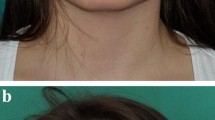Abstract
Background
Size of the nose varies in the different parts of the world, and perception of what is the aesthetically acceptable nose shows large differences depending on the ethnic background, type of the society, gender and age. Nose which is generally larger than the average nose in a given society, particularly regarding the height of its nasal bridge, could be defined as a prominent nose.
Methods
Photographs of the 414 consecutive patients who underwent rhinoplasty by the author during the years 2014 and 2015 were reviewed. Attention was directed to the following outer features: overall length, height and width of the nose, nasofrontal angle, nasolabial angle, nose-lip and nose-chin relations, shape and position of the chin and the evaluation of the respiratory function. Among determinants was formula of Goode, which delineates the approximate relationship between tip projection and nasal length.
Results
A total of 144 patients, 112 females and 31 males, who fulfilled criteria of prominent nose were selected for the further analysis. A total of 70% of the patients were of Middle-Eastern origin. The following four types of prominent nose were recognised: (1) short prominent nose, or tension nose was present in 38 patients. It has overprojecting dorsum, which usually forms a hump. Nasolabial angle is obtuse, and nasal spina is frequently overgrown. The rate of functional problems is quite high due to the overdevelopment and subsequent deviation of the septal cartilage. (2) Long prominent nose, present in 96 patients, usually has an arched dorsum, sharp NL angle and drooping tip. (3) Long nose depending on the height of the dorsum in the lateral projection can be the low long nose and it was seen in four patients, or when the nose is both long and the tip is overprojecting, it is called Pinocchio nose and it was present in eight patients. (4) Rhinomegaly is the term describing nose which is very large in all dimensions, the height, length and width and was also seen in eight patients.
Conclusions
Prominent nose has several modalities and each of them requires different techniques applied during the surgical intervention. Both aesthetic and functional topics are frequently present, and multiple nasal structures, both external and internal, are commonly involved. In the aesthetically pleasing Caucasian nose, Goode’s ratio should equal 0.55 to 0.60. If there is before operation unrecognised deviation from this norm, which is also persistent after the rhinoplasty, the final result will be substandard.
Level of Evidence IV, risk / prognostic study.

















Similar content being viewed by others
References
Niechajev I (2017) Prominent nose. In: Frame JD, Bagheri SC et al (eds) Aesthetic surgery techniques, Elsevier Publ, UK, chapter 15, pp, pp 111–119
Niechajev I, Haraldsson PO (1997) Ethnic profile of patients undergoing aesthetic rhinoplasty in Stockholm. Aesthetic Plast Surg 21:139–145
Niechajev I (2016) Noses of the Middle East: Variety of Phenotypes and Surgical Approaches. J Craniofac Surg 27(7):1700–1706
Foda HMT (2005) The role of septal surgery in management of the deviated nose. Plast Reconstr Surg 115(2):406–415
Parker Porter J, Toriumi D (2002) Surgical techniques for management of the crooked nose. Aesthetic Plast Surg 26:18–32
Türegun M, Sengezer M, Güler M (1998) Reconstruction of the saddle nose deformities using porous polyethylene implant. Aesthetic Plast Surg 22(1):38–41
Niechajev (1999) Porous polyethylene implants for nasal reconstruction: clinical and histologic aspects. Aesthetic Plast Surg 23(6):395–402
Niechajev I (2012) Facial reconstruction using porous high-density polyethylene (medpor): long-term results. Aesthetic Plast Surg 36:917–927
Tardy EM (1997) Anatomy of changes of ageing and sculpting of nasal tip. In: Tardy EM (ed) Rhinoplasty the art and science, Saunders, Philadelphia, Vol 2, p 526
Niechajev I (2012) Effect of the depresor septi nasi muscle on the nasal lengthening over the time. (editors invited commentary). Aesthetic Plast Surg 37:987–992
Jost G (1988) Supramucosal technique. In: Jost G (ed) Atlas of Aesthetic Plastic Surgery, 2nd edn . Masson, Paris Pp. 44–55
Gubisch W, Eichhorn-Sens J (2008) The sliding technique: a method to treat the overprojected nasal tip. Aesthetic Plast Surg 32:772–778
Guyuron B (2000) Dynamics in rhinoplasty. Plast Reconstr Surg 105(6):2257–2259
Neu BR (2001) Reduction of nasal tip projection with medial rotation of alar cartilages. Plast Reconstr Surg 108(3):763–767
Guyuron B (2001) Discussion: reduction of nasal tip projection with medial rotation of alar cartilages. Plast Reconstr Surg 108(3):768–770
Joseph J (1931) Die Zurücksetzung der abnorm prominenten Nasenspitze. In: Nasenplastik und sonstige Gesichtsplastik nebst Mammaplastik. Verlag Curt Kabitzsch, Leipzig, pp 131–148
Fredrics S (1974) Tripoid resection for “Pinocchio” nose deformity. Plast Reconstr Surg 53:531–533
Papanastasiou S, Logan A (2000) Management of the overprojected nasal tip: a review. Aesthetic Plast Surg 24:353–356
Sheen JH, Sheen AP (1987) Nostrils aesthetics and Types of alar resection. In: Sheen JH (ed) Aesthetic Rhinoplasty 2nd edn. St. Louis Miss. Mosby , Vol 1, pp 106–111 and pp 254–266
Apaydin F (2016) Projection and deprojection techniques in rhinoplasty. Clin Plast Surg 43(1):151–168
Peck GC (1990) Broad nasal tip. In: Peck GC (ed) Techniques in aesthetic rhinoplasty, 2nd edn. Lippincott, Philadelphia, pp 137–141
ISAPS (2016) International study on aesthetic/cosmetic procedures performed 2016, Grece. https://www.isaps.org/wp-content/uploads/2017/10/2016-ISAPS, Accessed 25 July 2016
Author information
Authors and Affiliations
Corresponding author
Ethics declarations
Ethical approval
All procedures performed in studies involving human participants were in accordance with the ethical standards of the institutional and/or national research committee and with the 1964 Helsinki declaration and its later amendments or comparable ethical standards. For this type of retrospective study, formal consent is not required.
Patient consent
Informed consent was obtained from all individual participants included in this study.
Conflict of interest
Igor Niechajev declares that he has no conflict of interest.
Rights and permissions
About this article
Cite this article
Niechajev, I. Prominent nose, its modalities and their treatment. Eur J Plast Surg 41, 543–556 (2018). https://doi.org/10.1007/s00238-018-1421-4
Received:
Accepted:
Published:
Issue Date:
DOI: https://doi.org/10.1007/s00238-018-1421-4



